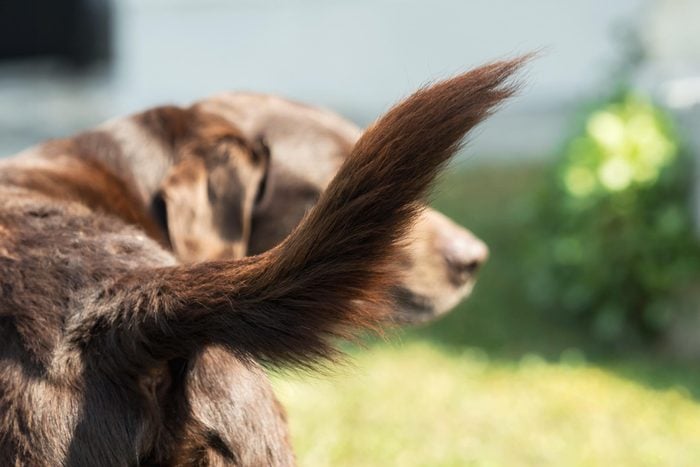
Wouldn’t it be amazing if our dogs could talk to us? We could finally make sense of some of their more perplexing dog behaviors, like being afraid of the tiny Chihuahua next door or barking only at the delivery truck but not other cars. While we can’t chit-chat with our dog, we can crack the communication code by observing its body language—and more specifically, translating dog tail meaning.
“The tail can be a prominent place that most dog guardians look to when trying to determine their dog’s mood because it can be so expressive, but it can be misleading,” says Renee Rhoades, a certified dog behaviorist at R+ Dogs, a virtual dog behavior consultancy. “It’s critical for dog guardians (and dog lovers) to understand dog body language as a whole, and that includes the tail.”
What is my dogs tail telling me?
Decoding dog tail meaning can be tricky, so we’ve asked five canine behaviorists and dog-training professionals for help figuring out what those cute little appendages are trying to tell us. Ahead, they explain everything you should know.
Get Reader’s Digest’s Read Up newsletter for more pets, humor, travel, tech and fun facts all week long.
About the experts
Reviewed for accuracy by: Wailani Sung, DVM, a vet with a board certification in veterinary behavioral medicine who works at the Behavior Specialty Clinic part of the San Francisco SPCA. Dr. Sung is the co-author of From Fearful to Free: A Positive Program to Free Your Dog from Anxiety, Fears and Phobias. |
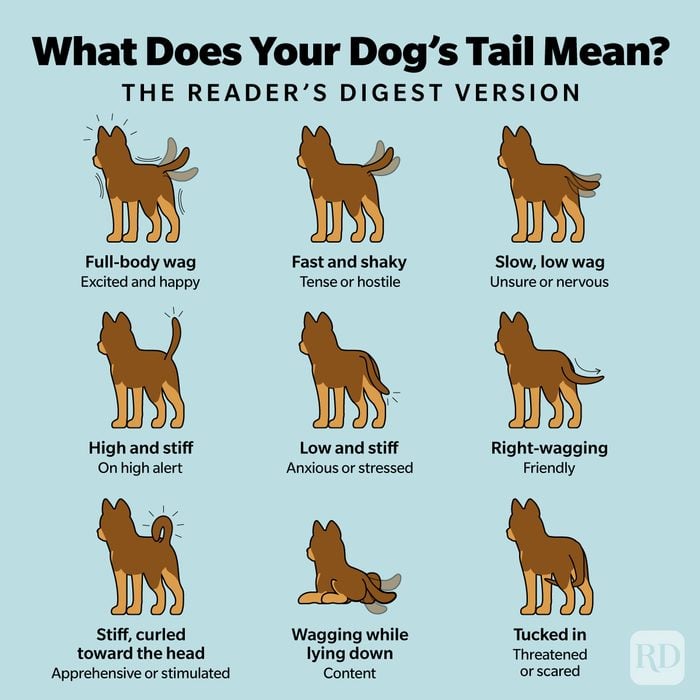
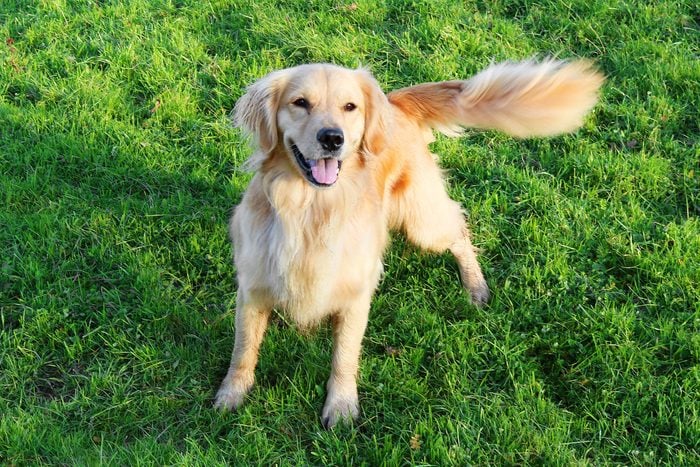
Full-body wag
When you see this type of wagging tail, there’s no doubt your dog is trying to show you love—it’s one of the reasons why dogs have tails, after all. You probably see this wag when you come home from work every night. Your pup welcomes you with big-circle tail-wagging. You’ll also see them loosely shaking their entire body, accompanied by a submissive grin or a soft open mouth. “The more swaying and wiggly motion closer to the head of the dog, the friendlier the dog is,” says Russ Hartstein, certified dog behaviorist and trainer and the CEO of Fun Paw Care in Los Angeles.
Fast and shaky
When you see a fast, vigorous, almost-shaking tail on a dog, take it as a cue of tension and/or hostility. The dog could spring into action at any moment. “This is a highly aroused dog and should generally be avoided until it settles down,” cautions Hartstein.
Slow wag
You can almost see it in its face: The doggo seems to be contemplating its next move. A slowly wagging tail may indicate that a dog is unfriendly, so proceed cautiously and don’t interact, especially if you don’t know the dog. It’s worth mentioning that dog tail meaning is just a part of a dog’s overall body language. The dog may not be unfriendly but merely surveying the situation, like a guard dog on duty. Still, if you don’t know the dog, it’s safer to avoid interacting with it.
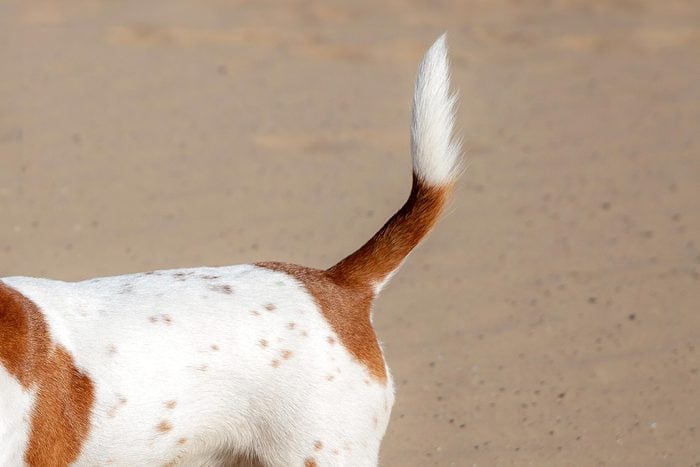
High
Talk about swagger. This high tail gives off a confident and enthusiastic vibe. But that’s not always the case. There are a few reasons why a tail is carried higher than the baseline. First, it could indicate they are excited—in a good or a bad way. “They may raise their tail if they see someone or something they strongly dislike,” says certified dog behaviorist Mindy Waite.
They may also hike up their tail after they poop. “When dogs carry their tails higher, their scent glands are more exposed, which lets others know, ‘Hey, I’m here,'” says certified dog trainer and vet technician Julie Burgess. Finally, a high tail could also indicate the dog is being possessive over an object, such as a toy.
Stiff and high
A stiff and high tail could mean the dog is highly aroused by something and ready to do something about it. “For example, if the dog generally dislikes strangers and a stranger suddenly pops out from around the corner, the dog’s tail may go stiff and high right before the dog barks, growls or lunges,” says Waite.
Stiff and low
When the tail is stiff and low, it could mean the dog is anxious or stressed. “The dog is uncomfortable or unsure about something but potentially less likely to move forward toward the stimulus,” says Waite.
Stiff
If the tail is just stiff, not necessarily low or high, a dog could be asking for your help because their its is injured. “If your dog is carrying its tail in a stiff position and you don’t feel they are anxious or stressed, we recommend having your dog evaluated by your veterinarian as soon as possible,” says Burgess.
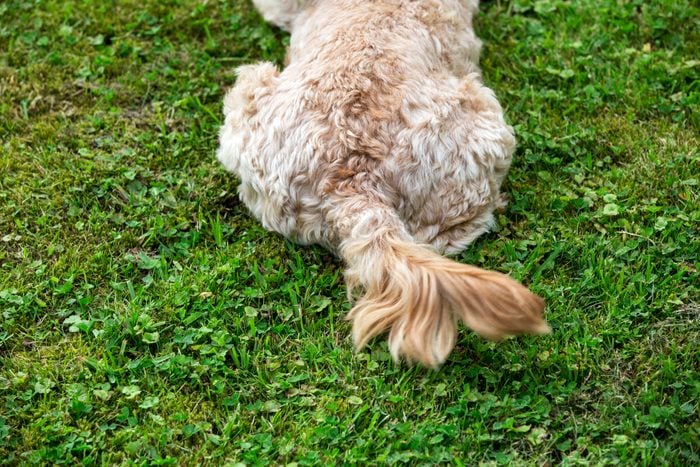
Wagging while lying down
Dogs don’t have to be standing to express their emotions via their tail. “You’re more likely to find relaxed or appeasement behavior while the dog is laying down. A dog who is apprehensive or fearful is more likely to be standing, ready to move,” says Rhoades. You might see this when the dog is relaxing on the sofa and wagging its tail tentatively in appeasement, not wanting to be moved from its favorite spot. You can spot this when you walk into a room or come out of the bathroom and it’s lying on the floor wagging its tail, happy to see you and hoping for a belly rub.
Wagging to the right
Sometimes you have to take a closer look to determine which direction the wag is going to assess dog tail meaning. When it’s veering to the right, it’s generally a telltale sign a dog is happy to see you. “The left side of a dog’s brain is the section where pleasant feelings like calmness and happiness are,” says Burgess. And since the left side of the brain controls the right side of the body, it supports a research study suggesting wagging on the right indicates a friendly dog.
Wagging to the left
In the same study, the data suggested wagging to the left could mean the dog is contemplating an escape because it is fearful of something or someone. “It can also mean your dog is sad,” says Burgess. Interestingly, additional studies implied that when dogs see a left-wagging tail on another dog, they are more likely to show stress-related behaviors, another indicator that left-wagging tails point to uncertainty or an uncomfortable dog. However, Waite points out that more research is necessary before experts can make any reasonable conclusion regarding left wagging versus right wagging when it comes to dog tail meaning.
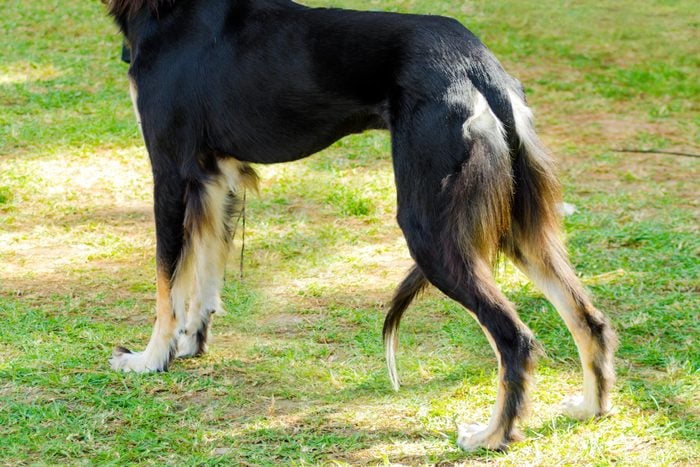
Tucked in
Slightly different from a pulled-down tail, this version appears tucked between the back legs. “This can mean a dog is feeling threatened or is fearful of the situation he’s in. A tail tucked between the legs covers a dog’s genital area for protection,” says Erin Askeland, a certified dog trainer and canine behavior consultant at Camp Bow Wow.
Pulled down
This is a great way to find out what your dog actually wants from you. Here, the tail is being held at a low level, often covering the dog’s anus but not yet disappearing between the dog’s legs. “A tail that is pulled down shows a dog is not entirely comfortable with the situation he’s in and could be feeling anxious, nervous or unsure,” says Askeland. “A tail wag or wiggle may also be included as a sign of appeasement.”
Curled toward the head
There are a few things to take into consideration with this scenario: Some tails naturally curl or bend toward the head—like the cute tail on a pug. With these dogs, it generally means they are relaxed. But if the tail is stiff (or pulled) toward the dog’s head, it could indicate apprehension, overstimulation, high alertness or high excitement. Additionally, if the tail makes tiny movements side to side while pointing toward the head, it could indicate the dog is apprehensive or excited, depending on the dog, Rhoades says.

Stubby or curly
What about those breeds with stubby or curly tails? They still mimic the same signals as those with straight or long tails but may not be able to exaggerate this expression the same way. “A key component to reading tails that are stubby or curly is to look at the base of the tail. Since the tail is attached to the spine, any movement of the tail starts at the base, so if you look at the base of the tail, you can see when a stubby tail is raised straight up, in the air, or tucked down over the butt, etc.,” says Askeland.
Half-mast
When the tail is positioned at medium height, wagging slowly, it signals your dog isn’t feeling particularly social. It doesn’t necessarily imply that the pup is feeling grumpy. It’s just more of a “meh” feeling and not particularly dominant or submissive.
Limp
The tail isn’t just a cute appendage. It is an extension of a dog’s backbone with vertebrae, and it’s a sensitive part of a dog’s anatomy that’s prone to injury. “A limp tail, one that cannot wag, is a problem and can mean a dog has an injury directly to the tail or to other connected areas. A tail can be sprained, broken, dislocated or have nerve damage that causes it to go limp,” says Askeland. Check in with your vet, as damage to the tail can cause various issues, including incontinence, balance issues and the inability to use the tail to communicate.
Since your dog can’t specifically tell you which emotion it is feeling, it’s essential to seek other signs of body language to get the whole picture, including knowing the dog tail’s meaning. “I like to advise clients and the public to take my ears-to-tail approach. Start at the dog’s ears, moving down their body all the way to what the tail is doing to give you a wide spectrum on all of the communication cues the dog is expressing physically,” says Rhoades. Then zoom out and observe the surrounding environment. For example, when a dog’s tail is tucked, it’s crouching and the whites of its eyes are prominent, it’s likely anxious and nervous.
Why trust us
At Reader’s Digest, we’re committed to producing high-quality content by writers with expertise and experience in their field in consultation with relevant, qualified experts. For this piece, Lisa Marie Conklin tapped her experience as a reporter who has covered dogs and pets for seven years, then Wailani Sung, DVM, a vet with a board certification in veterinary behavioral medicine who works at the Behavior Specialty Clinic part of the San Francisco SPCA, gave it a rigorous review to ensure that all information is accurate and offers the best possible advice to readers. We verify all facts and data, back them with credible sourcing and revisit them over time to ensure they remain accurate and up to date. Read more about our team, our contributors and our editorial policies.
Sources:
- Renee Rhoades, MSc, BSc, Adv.Dip, FFCP, multi-certified dog behaviorist and founder of R+Dogs; email interview, Feb. 6, 2024
- Russ Hartstein, CPDT-KA, CDBC, certified dog behaviorist at Fun Paw Care in Los Angeles; interview, July 2019
- Mindy Waite, PhD, CAAB, CPDT-KA, certified dog behaviorist at the site Senior Tail Waggers; email interview, Feb. 6, 2024
- Julie Burgess, CPDT-KA, certified dog trainer at the site Senior Tail Waggers; email interview, Feb. 6, 2024
- Erin Askeland, MSc, CPDT-KA, CBCC-KA, canine behavior consultant at Camp Bow Wow; interview, July 2019
- Current Biology: “Asymmetric tail-wagging responses by dogs to different emotive stimuli“
- Current Biology: “Seeing Left- or Right-Asymmetric Tail Wagging Produces Different Emotional Responses in Dogs“